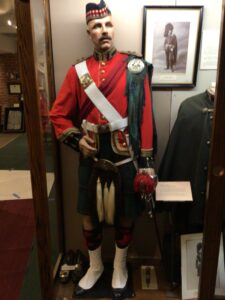This Full Dress, Review Order is the original Uniform worn in 1892 by Lt. Col. John Irvine Davidson, first Commanding Officer from 20 November 1891 to 1898.
The first uniform ordered in 1891 by the 48th Highlanders was a traditional scarlet Full dress uniform, patterned after that of the Gordon Highlanders of Aberdeenshire. The headdress is a black ostrich-feather bonnet 28 centimetres tall, built around a wire frame. On its right side hang a series of feather tails, five for officers and four for other ranks. On the left is a hackle, a tall white plume of vulture feathers and below the hackle, originally to keep the feathers in place, is a regimental cap badge. The 48th cap badge drew its design from the family crest of LCol. Within the badge is a couped Falcon head, and the motto ‘Dileas gu Brath’ (Gaelic for ‘faithful for ever’). A Scottish belt, intended to symbolize the clan, surrounds the badge
The Highlander’s jacket, the doublet, is cut to compliment the kilt. For all Highland regiments it was cut from the same scarlet cloth as the jackets of the British infantry, based on the St. George’s cross. The collar and cuffs, or facings, display distinctive regimental colours. The 48th wears blue, a colour authorized by Queen Victoria for all Canadian Militia infantry. The pattern of buttons was unique to regiments; in particular the buttons surrounding cuffs and pocket flaps. Originally, these buttons held the fold of the cuff and the braid around the pocket and prevented the material from stretching around the holes. By the 1850s, cuffs no longer unbuttoned and for Highlanders they had become gauntlet shaped. The 48th doublet has three buttons on the cuffs and another eight down the tunic front. Two buttons, which previously may have supported the belt, are along the waist at the back. Below the waist hang four skirts called Inverness flaps, with pockets in the two flaps in the front. Each Inverness flap has three buttons, seemingly just to create harmony with the buttons on the cuffs.
Depending on rank, the doublet is enriched with gold thistle lacing and Russian gold braiding. The other rank’s doublet lacks any lacing or braid and on the shoulders has simple epaulets of scarlet cloth with brass “48” numerals. Junior NCOs display their rank with white chevrons on the right sleeve and Sergeants, who wear three gold chevrons, add a red sash worn on the right shoulder. The junior officer’s doublet has gold lace on cuffs and collar, gold cord around buttons and twisted gold cord on the shoulders on which he wears his rank. The field officer adds gold lace around the Inverness flaps. The officer’s sash is of crimson silk, worn on the left shoulder.
Below the doublet, the Highlander wears a Davidson tartan kilt with a sporran hanging in the centre. The officer’s sporran has a brass top etched with Scottish thistles and three tails with similarly etched brass caps. Diced hose (black and red checkered coloured socks) are held in place by a garter. White spats, fastened by eight white buttons, cover and protect his shoes. The 48th officer wears more elaborate garters called “The Belled Flashes”. These were adopted by the Gordon Highlanders to commemorate their joint action with the Royal Scots Greys at the Battle of Waterloo. Seen from the front they resemble the stirrup to which the Gordons held fast during their famous charge with the Greys on 18 June 1815. Officers’ spats have 10 black buttons. “The Black Spat Buttons” was one of the oldest traditions of the Gordons, worn in perpetual mourning for General Sir John Moore, killed at the Battle of Corunna in Spain in 1812. The officer wears black brogues instead of ordinary shoes and in his right hose top a sgian dubh (skean dhu), a short knife, also worn by the Regimental Sergeant Major, the Drum Sergeant Major and the Pipes & Drums.
The officer’s uniform is further differentiated by the equipment he carries. The officer wears a white leather baldrick (a wide strap) over his right shoulder and a waist belt on which hangs his sword, the claymore. traditionally called a Scottish Infantry Basket Hilted Broad Sword. From his left shoulder, held in place by a brooch, is a belted plaid, once the upper portion of the ancient kilt. Field officers (majors and above) embellish their sword belts and baldrick with gold lace and suspend a dirk (a large Scottish knife) on the right side from the belt.
In the field the soldier carried his possessions in a rigid knapsack on his back to which was strapped his greatcoat and a mess tin carrying his meat ration and serving as a cup and plate. Draped from one shoulder and crossing mid-chest was his water canteen and on a white waist belt a bayonet scabbard and ball bag for rifle ammunition. Over one shoulder, the officer carried a haversack for his bread ration. That the officer did not carry field equipment, such as knapsacks, was a demonstration he did not work but led. His claymore was symbolic, a connection with the feudal past and weight of historical authority and, only used in hand to hand fighting, further demonstrated his status as removed from participating in active combat.
Technical
Glengarry with original cap badge – glengarry has marking W6D 1913
Tunic with gold cords and rank, pips and crown of Lt. Col. ; buttons x 22 by Crean & Rowan; “Stillwell & Son London” Tailors tag “Austin & Workman” Toronto
Horse hair sporran Officer pattern made by Crean & Rowan Toronto.
Gordon pattern kilt, worn by Davidson until kilt in Davidson tartan had been purchased for the Regiment in 1892
Officers silk sash + belted plaid + buckle; White, leather waist belt with original belt buckle; white leather baldric
Diced hose; garters officer pattern “Belled Flashes” ; 10-button spats
Brogue shoes
Claymore (Scottish infantry basket hilted broad sword) attached to sword sling (belonging to LCol Trumbull Warren)

